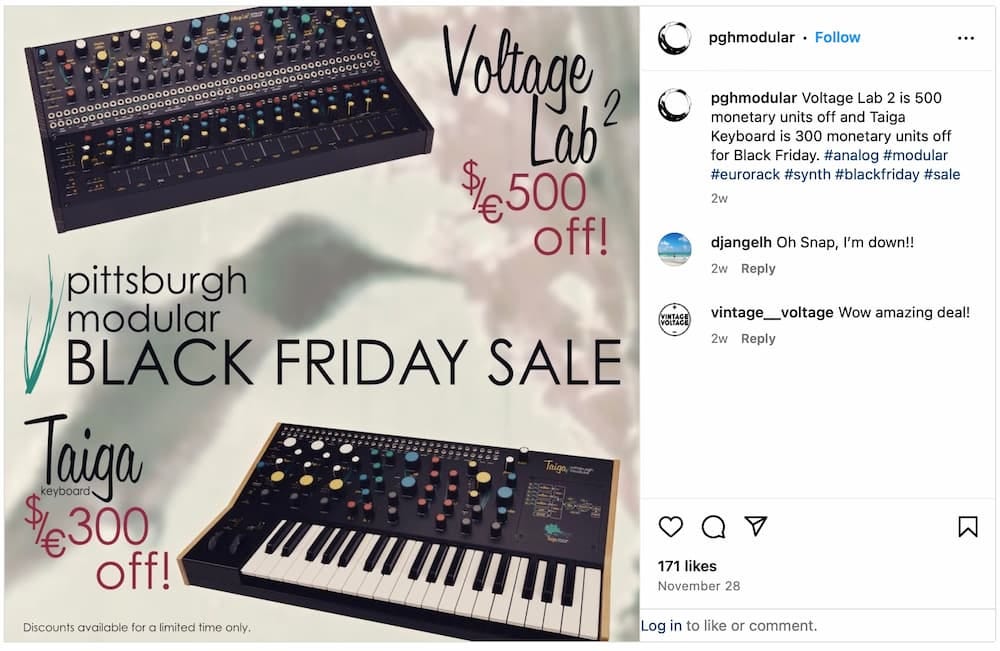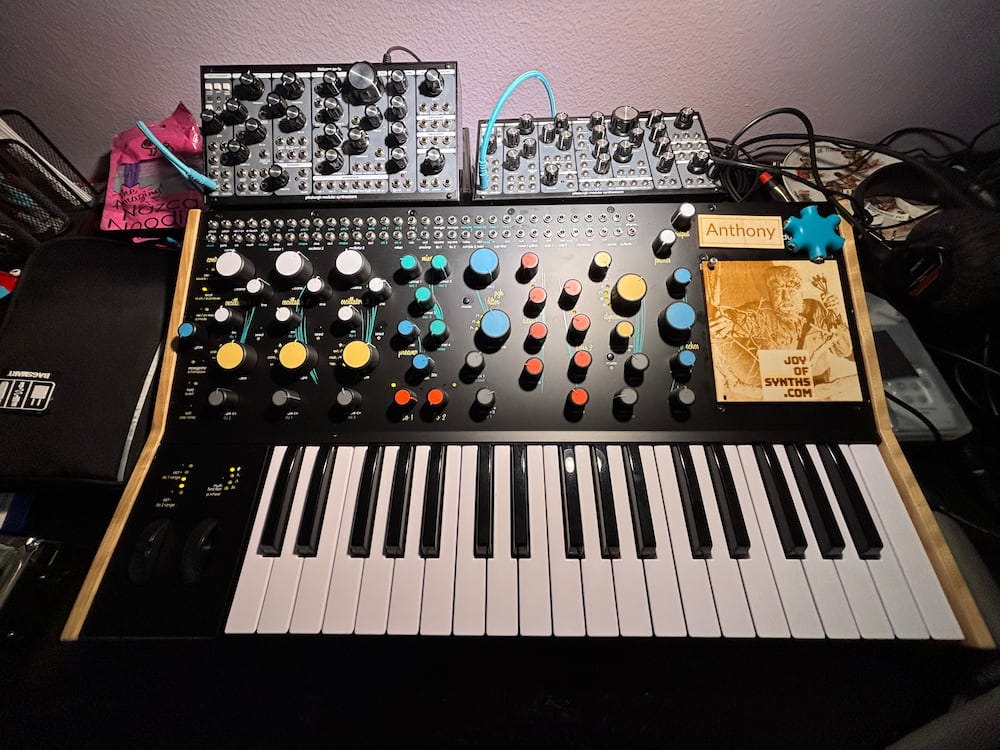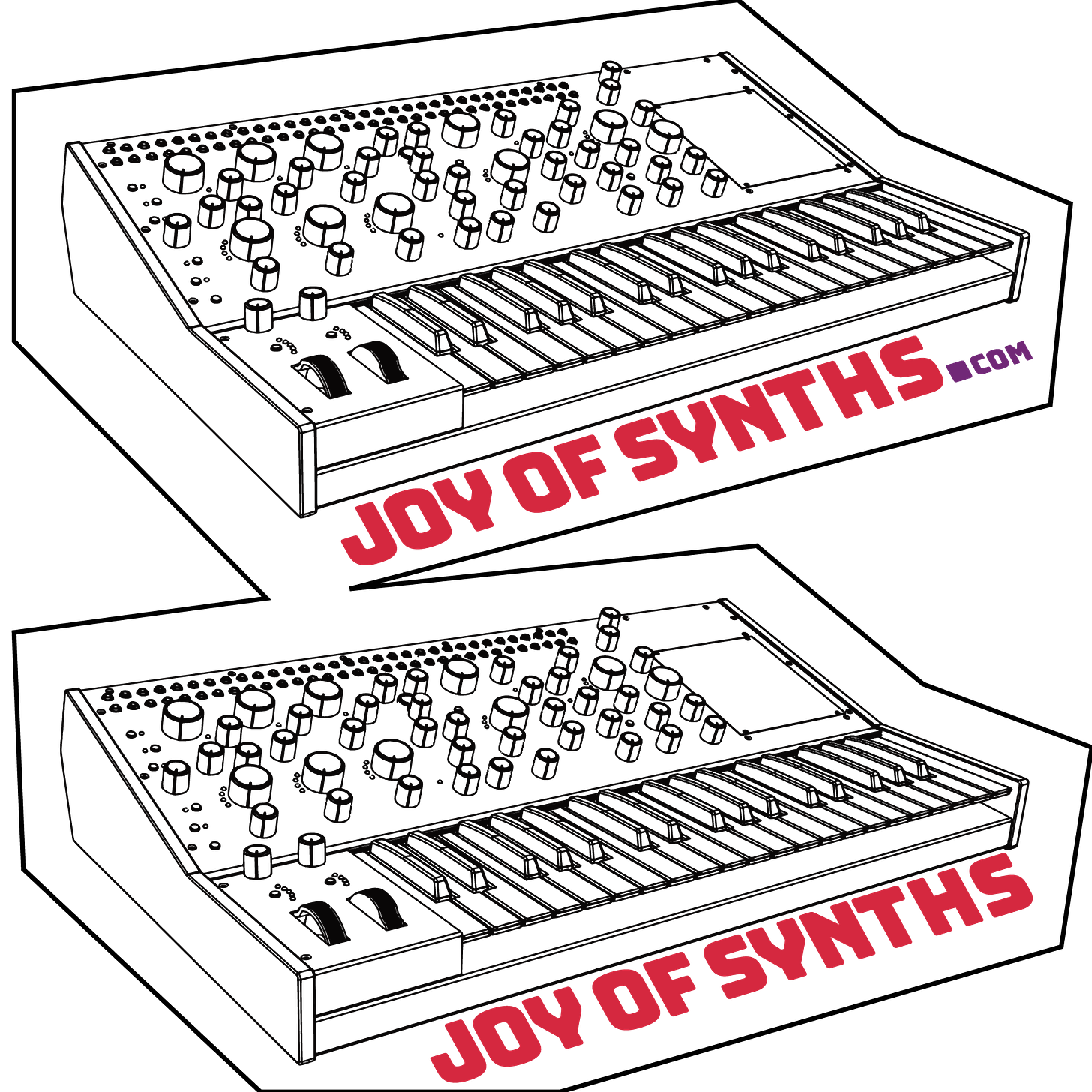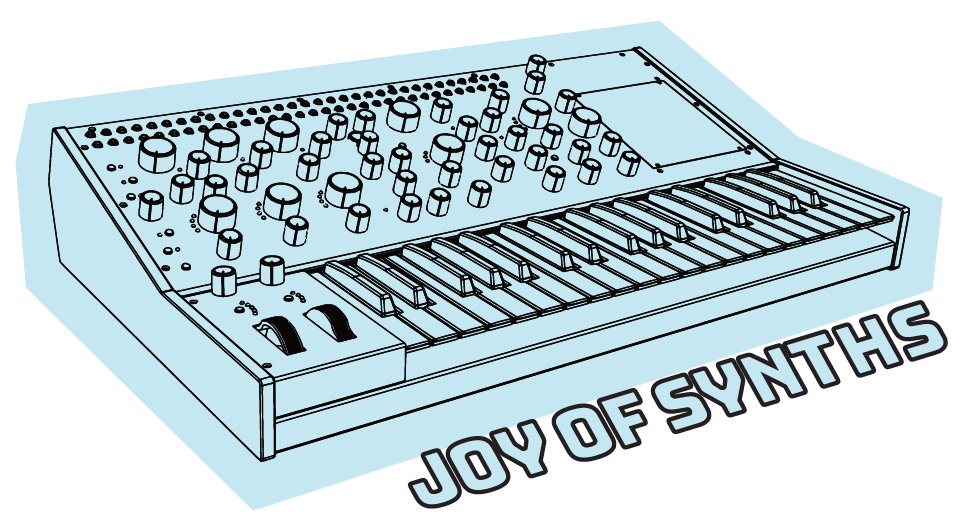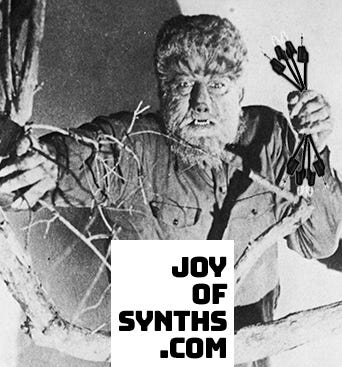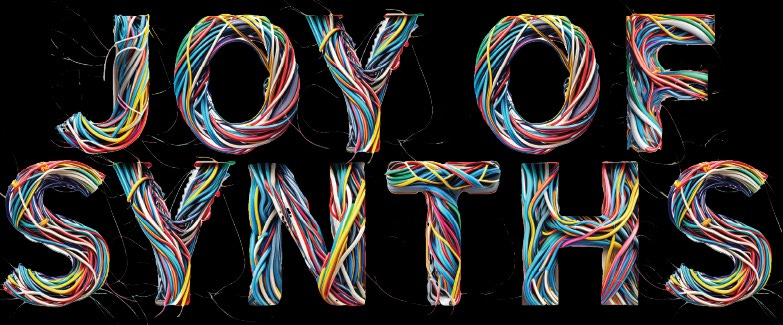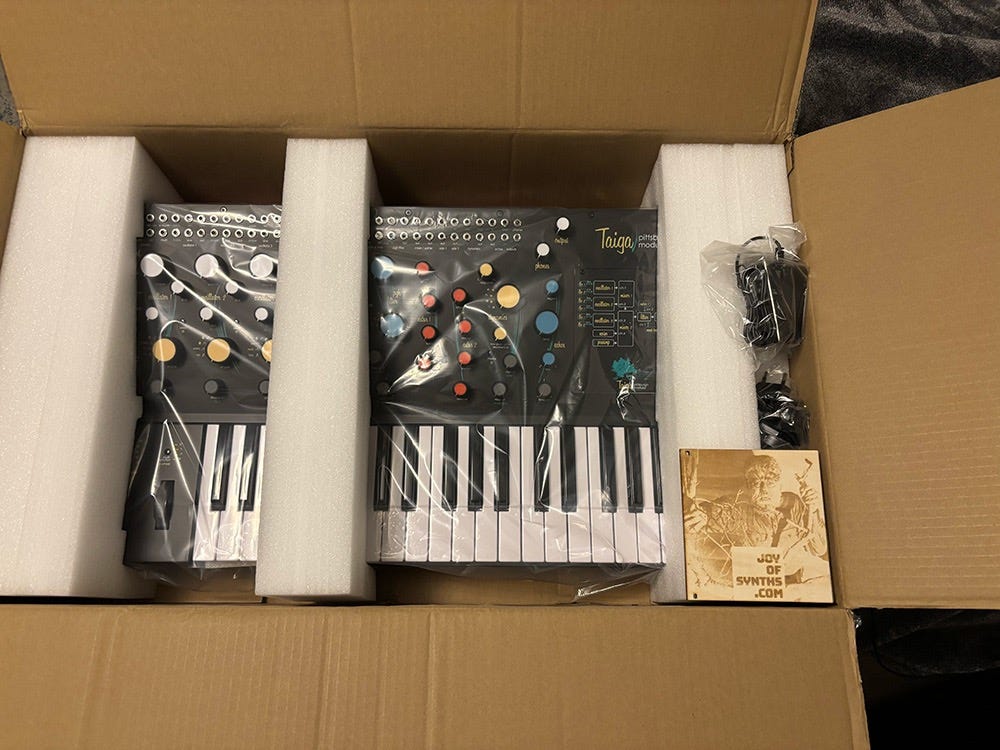Joy of Synths 32: Taiga KB
Taiga Keyboard journey in this non-musician’s guide to creating sounds for podcasts, videos, and sampling for music using analog synthesizers.
LAST LAST SYNTH (of 2024)
MONDAY 12/23/2024, 2:52 AM
This is publishing on 12/25/2024 to provide diversion for your Holiday exhaustion or regret. It’s a long read journal presented in reverse order. Take any angst and obsessiveness for what it is: synth survivor’s guilt. Or shame. Or both.
To summarize, I swore off buying synths after spending $483 on a pre-owned SV-1b in September. On December 1, I impulse bought a (Amazon affiliate link) Taiga Keyboard off a Black Friday/Cyber Monday deal of $999 plus 20% Amazon Coupon for $799 + $53 tax. The deal was too strong to say no. It arrived December 8th. I finally played it December 17th. Details below.
Sunday December 22, 2024
After 1 hr 20 minutes of recording, the Taiga Keyboard (TK) was moved to a proper sound work desk (a larger wood desk). As it stands the TK is a wonder to play without patch cables. It has modulation coming from LFOs and the Mod Wheel of the Keyboard. It only gets more interesting when rewired. The Taiga Keyboard box includes a total of 10 patch cables, which echoes the East Beast’s inclusion of patch cables.
Saturday December 21, 2024
PROBLEMS AREN’T PROBLEMS
I did a simple check of the preamp by patching an oscillator output sine wave to the Preamp Input, and the Preamp Output to the final output Left Input. If this didn't affect the sound then there would be an issue. Thankfully the volume and sound quality changed so the Preamp is working, it just might not be in the signal flow path and require patching in. I’ll sort that out later. However, crisis averted, given Amazon’s exchange issues.
Amazon’s Policy Problems
Amazon is amazing with returns. Make the request, state the reason, ship it back for free at UPS Store. What about exchanges for goods damaged in transit?
I have a sinking feeling the Taiga Keyboard’s preamp is broken (it’s not). So maybe just exchange it for another unit at Amazon? Not so fast. Here’s the problem.
“Items purchased with a promotion do not quality for an exchange.” So that 20% coupon that knocked off $200? Does that qualify as a promotion? Likely.
“Amazon does not price match. If the price of the item you're exchanging costs less than the price of your original item, we'll refund you the difference. If the new item costs more, we'll charge you for the difference in price.” If I understand this correctly, Amazon doesn’t price match itself. Which is true if you are told to return the item and repurchase. In past price drops, they wouldn’t resell a replacement at the same price. Talking to a rep by phone in this situation has helped in the past. Their one time solution was to process a refund and let me keep the damaged item.
Friday December 20, 2024
EVOLVING NATURE OF GOALS
I found a 2018 declaration of my love for synths and the sheer joy of hearing sounds emerge amidst a struggle understanding with how a synth works
This initial goal persists: record interesting sounds. After exploring iOS music apps it has focused to record interesting sounds with analog synthesizers.
Other goals arose and continue, namely, learn how a synth works so sound exploration is more consistent than silence. Each instrument has merits of its own and in combination with other modules or sections of another synth (why this is called Joy of Synths rather than a solo synth). Sound making is more questions and exploration than diagnostic and prescriptive. One can choose to pursue the art of science or the science of art, or meander between those spaces.
ACCESS
Gaining access to a good-for-me instrument has been an invisible underlying goal/need I only now understand.
I confused this with shopping mania, given the rush of adrenaline and flood of serotonin when acquiring new gear. A simple question to break the shopping cycle or at least put a pause in it is to ask “what perceived need is this item supposed to fill?”
My introduction to synths started with access to the SV-1. Ownership would involve a $699 expense I could not justify. Once it was apparent I needed to own for more time on the instrument then I proceeded the best way I knew how: foolishly. I bought and returned my way through brands, arriving at an introduction to littleBits Korg Synth Kits as the first modular set up I understood and enjoyed.
I continued by buying every littleBits kit, building up this collection for the possibility of great sounds. At the same time I began buying semi-modular instruments on the hopes of something like the SV-1b but cheaper. That didn’t materialize as every instrument has its own merits based on the quality of oscillators and filter and envelope generator and delay when available.
Because with synths and their turns of the dials, it’s my belief that interesting sounds are as much about the instrument as the individual. Some folks will start collecting vintage instruments for their unique sounds. My initial option was investing in newly released semi-modular instruments as that’s what I had funds for in 2019. I was fortunate to buy when the instrument was discounted in some fashion by Kickstarter or Amazon price drop or Perfect Circuit sale.
This desire for access through ownership is satisfied with the The Taiga Keyboard. Others may want to progress to polyphony and digital synthesis but I’m happiest with analog monophonic synths, either solo or in combination with one another.
Taiga Keyboard (Manu page link) is where my access through ownership goal lands. Any and all needs are met. After several years of wandering through the online aisles of possibility, this is an IRL instrument to commit to. It has three oscillators and a built-in controller and an expandable Eurorack rack. It’s a Pittsburgh Modular synth so I’m back to where I started in 2018 with their SV-1. Only it’s in house and I don’t have to borrow time to play and record it when I could get a sound out of it.
Again, access through ownership has been a driving goal over these years, one I acknowledge this morning at 3:30 AM. Recognition of this is important. New goals must fill that psychic space as one may be simultaneously elated and depressed by attainment of a goal/need. The trick is to move forward. Onto the next one, which is committing to recording the Taiga Keyboard as an instrument of choice and hub for connecting to other synths and modules.
PARAPHONIC, DUOPHONIC AND POLYPHONIC
Taiga Keyboard is paraphonic and can play two keys at a time through some setting. The same goes with Behringer synths that are able to count their place in a MIDI chain and play the first, second, and third key pressed if you have three synths connected MIDI IN and MIDI THRU. This is why some folks have three Behringer Model Ds racked together. It allows them to play a musical chord (3 notes), well, a chord that may or not be musical.)
ON BUYING “EXPENSIVE” GEAR
With a background in film and video production and camera buying, well, a nice image really does come down to the camera sensor and lens and support gear and lighting and subject and environment in front of the camera, in addition to some skill as a shooter. So it’s everything: gear and imaging and individual. Some individuals can overcome gear limitations but it’s like shooting Super 8mm film and hoping for 35mm cinematic results.
From my experience buying consumer grade still and video cameras in place of professional grade cameras, I painfully found it more cost-effective to buy the professional grade gear. Pro gear may be easier to use by offering more features.
However, I gave up buying camera gear before the explosion of content creation, so perhaps more cost effective gear has emerged. But this ethos persists as value can be measured in useful life. My 2009 Canon 7d is still great for shooting high definition video in 2024. The lower priced Canon T-series cameras lack a dedicated dial for ISO. This may not seem like much but it does make a difference when you need to rapidly change ISO for exposure.
Vintage cameras I collected for one year didn’t yield much in the way of usable photos. I added up the cost of useless cameras and processing of useless photos and it exceeded the cost of a brand new photo camera and lens.
Obsolesence is another factor. The cutting edge 360 Video VR camera system I preordered in 2016 and received in 2017 stopped being useful by 2020 when I accepted there was no reliable way to release and consume that content online. Plus you had this whole “behind the camera” space to worry about. This is why I stopped investigating ambisonics and binaural head tracking in game systems. Stereo panning is fun but I notice most folks listening to streaming on their phones with one earbud, negating the two ear interplay possible with stereo panning.
TAIGA vs. BEHRINGER
Ultimate point being that in my case, having played through a lot of very affordable Behringer synths, at the $799 price I paid for the Taiga Keyboard, it makes more sense to have one Taiga Keyboard than multiple $220 Behringer synths. The cloned Solina String Ensemble, Model D, and Kobol Expander are not regrets but I would trade those plus the Neutron, cloned K2, 2600 and 2500 Eurorack modules for a Taiga Keyboard. Put another way, it would be cheaper and take up less space to own one Taiga Keyboard than several Behringer synths and controllers you may soon outgrow. The build, manuals, and features are just better. Discounted resale value of either are about the same as they are still in production.
The same goes for Pittsburgh Modular/Cre8audio’s East Beast, and how two of those are the same cost as 1 $500 used PM SV-1b module yet you’re better off spending on the SV-1b as it is far superior. From a zero sum perspective, it’s not that you’re saving $250 by going with an East Beast. It’s that you have $250 less for a used SV-1b module.
(Powered SV-1b Blackboxes are hard to find with shipping and tax below $500 but I did get mine for $482 like new in a beat up box. Stupidly found that by Google search after looking on Reverb.com for SV-1b Blackbox listings that were really modules only.)
Thursday December 19, 2024
SIDEBAR: Personal Pantheon of Pittsburgh Modular Semi-Modular Synths
As the heading says, this is my personal experience with owning Pittsburgh Modular semi-modular synths. I’m not a completist but I am thrilled by this collection because I really like the sound they produce more than other synthesizers I own or recorded.
SV-1 Semi-Modular Eurorack Module (loaner not owner)
Silver semi-modular synth that packs a lot in a compact form. This is what I was introduced to as a synthesizer. I spent a lot of time trying to get sounds out of it because I didn’t understand that a controller of some sort is very necessary. (Now I know you can patch the MIDI clock output into the Envelope Generator input to play the EG dials without a keyboard controller.)
It has a single Envelope Generator that controls the Filter Frequency Modulation and Voltage Controlled Amplifier Modulation. Other synths will dedicate an Envelope Generator to each. However, despite the silence, it was a joy to play with. Starting in November 2018 I attempted to replicate its sound with other synths of lower price points. Everything else doesn’t share the sonic quality of its oscillators, mixer, filter, or envelope generator.
While PM had another synth available I opted to buy the Voltage Research Lab as they had similar features.
Voltage Research Lab (2019)
This is a totally different paradigm from the SV-1. It’s essentially a re-imagined Buchla system which is great if you have a vague understanding of Buchla systems and function generators and lopass gates. I did not until I binge bought Buchla Tip Top Audio Eurorack modules a few years later. VRL has more modulation points than modulation sources so it’s worth combining with another non-Buchla inspired synth. It also has the Primary Oscillator which is modulated by the Secondary Oscillator in really interesting ways. Iterations of this waveshaping Oscillator would go on to the Capt’n Big O module minus warping, West Pest semi-modular synth, and Taiga, and updated with Harmonic Interpolation Flamingo integration in the Voltage Research Lab 2.
SV-1b Blackbox (2000)
This uses the dark scheme of Voltage Research Lab, perhaps a few things were tweaked from the silver SV-1 but changes appear cosmetic. I bought a second SV1-b 2 years after buying the East Beast because the East Beast is not the SV-1b and combining 2 is a lot of fun. The SV-1b is the synth I should’ve bought as it’s easier to understand and more capable for learning as its genius unfolds as you develop an understanding of synthesizing sounds by working through its manual.
East Beast (2022)
I returned a Behringer 2600 to pre-order what I thought was an SV-1b lite with a button pad controller. East Beast is a single oscillator with the Pittsburgh Modular Filter and an LFO. Traces of its MIDI implementation migrated to the Taiga Keyboard. It lacks a mixer and multiple oscillator wave shape outputs and filter outputs, which is why I bought the second SV-1b after recording an SV-1b and SV-1 connected together in the Melrose Center Audio Studio.
Safari Series of Eurorack Modules (on going)
I bought the Harmonic Interpolation Flamingo, two actually, because it did something I didn’t quite understand but seemed important enough to own. I’m glad I did, as this is integrated into the Voltage Research Lab 2 oscillators. Taiga Keyboard has its 24HP of Eurorack space, so 2 of these 8HP modules leaves space for another 8HP module.
Taiga (2023) (For reference only)
My ownership of the VRL made me feel like this wasn’t quite a Voltage Research Lab 2, which I was looking forward to. Of course the Taiga is its own instrument, however, there was a few years of Safari experimental Eurorack releases to hopefully integrate into this next complete instrument.
Taiga Keyboard (March 4, 2024)
This is an update to the Taiga and sweeping break in form from previous Pittsburgh Modular synths. The size and weight and dial layout is both a blessing and a hindrance. You can carry an SV-1b Blackbox in the palm of your hand and store it easily in an Ikea bookcase. TK is a two arm affair that requires a desk or table. So far it is an impressive joy to look at. I’m not a keyboard player and this doesn’t inspire me to become one, yet. It’s arpeggiator does that heavy lifting. However, that I can expand it with other modules is a nice migration of the PM designed Nifty Keys controller/eurorack.
RTFM
I’m effectively back to square one with Pittsburgh Modular synths. I like the sounds so far but will have to read the manual in full to understand the keyboard controller. If a synth were so easy to understand then it wouldn’t need a manual, so I’m grateful for it. A number of recent synths by Behringer I’ve come across don’t have an explainer manual so you’re left to sort it out for yourself why that specific synth is special. Kind of a shame because it misses an opportunity to educate people on synth innovations.
6AM ETERNAL RECORDING
I recorded 40 minutes, effectively closing out a 32GB SD Card that began use on October 1, 2024 in Boston.
The Oscillators and Envelope Generators were responding to the Arpeggiator. The trick is to ensure the Arpeggiator button is lit up, press down as many keys as you want and then press the Hold button on the first section of the TK. You can release the keys and it’ll play those keys on a loop.
I’m gravitating towards the Echo to adjust the sound quality. Patching an LFO Triangle output to the Echo Time input creates interesting effects if the LFO is slower.
Upon listen to the recordings from 12/17 to today, there are more than enough sound effects, beds and audio transitions to apply to projects. Next step is to edit, label, and export them for use. These are up to an hour long files so the best way to edit is yet to be determined. I’ll read through the Sound Effects Bible book by Rick Viers to gain some insight in their workflow.
TAIGA KEYBOARD FIRMWARE UPDATES
There is an 1.2 update for the TK that expands its functionality. I’ll need to update that tonight. The TK is the first Pittsburgh Modular synth that has an accessible USB port on the back. Other recent PM synths require removing the module from the powered box to access a USB port. The update adds USB MIDI to that port amongst other improvements. My dream of playing MIDI rolls through a synth is coming true. This is already possible using a bridge like the Korg SQ-1 step sequencer, but to be able to direct connect from the Taiga Keyboard to a computer is perhaps less cumbersome.
Wednesday 12/18/2024
I spent Tuesday evening recording the Taiga Keyboard for 90 minutes. I am unable to have the call/response of a keyboard key press and a resulting synth reaction. The MIDI engagement is by a series of buttons, which reminds me of the MIDI on the Voltage Research Lab. Which is to say, I need to read more than the Taiga Keyboard Quickstart Guide pdf.
The arpeggiator appeared to work, or else it was the clock that was driving the envelope generator and voltage controlled amplifier. Regardless, the sounds were interesting and the Taiga Keyboard will require a further investment in play and study to somewhat control it with note on/off.
The size of the instrument is such that playing with the dials is a lot like the sliders on the ARP 2600 in that the layout is spacious and modules/sections are well distributed. The Taiga Keyboard’s size is such a departure from the compact nature of most Eurorack modules and semi-modular synthesizers.
ECHO ECHO ECHO
The Echo delay section responded as I hoped. It’s not a Strymon Big Cloud guitar pedal but it is an analog delay that will feedback upon itself in percussive ways. Here is where the larger dials make sense. The Time dial’s throw translates to finer tuning of the effect. And it seems to be full dry and full wet so all that passes is the Echo effect unlike the Delay on the first VRL.
An echo delay is the dirty secret of synths in that a lot of sound demos muddy the waters by running the instrument through a delay not included in the instrument. A delay gives more dimension to the sound.
A trail can be added to extend a sound using the Decay Sustain and Release controls of the ADSR envelope generator. But this isn’t the same as an Echo.
ECHO VS REVERB
A difference between echo and reverb comes to the physical world. A handclap in an empty room will have an extended trail but it doesn’t repeat, like Helloooo. A delay is like yelling into an area that will repeat the sound over a period of time with diminishing loudness, like HELLO Hello hello.
RE-AMP RE-RECORING
Natural reverbs are manipulated by the size of the room. A recording technique is to re-amp in different sized spaces than the original direct in recording of say a guitar. The original recording is played back through the amp into the room and other microphones are placed in the space to pick up the reverb. This reverb recording will then be mixed in as needed.
Folks have experimented with playing synths in caves and canyons and recording the sound coming through speakers. Way back when scientific oscillators were used for electronic music this was a means of dirtying up the clean sound. Present day there are modules and guitar pedals that can give you close enough results without worrying how to power everything in a remote space.
A suggestion for time efficiency is to use the above re-amp technique. Edit down recordings to your favorite passages and then play those back through an external amp in the space. The only problem is that some speakers prefer the mid-range of frequencies at the expense of the lower bass frequencies. A flat response speaker is the way to go.
If you want to be an analog purist, you could just feed into an amplifier direct from the synthesizer and then record that signal. Synths like the Behringer Model D have 2 outputs so you can direct record the synth signal and the environmental sound of the amp.
In my limited experience I found the results less than stellar, likely due to my limited experience with choosing the right amp and the right space and the right stereo mics and their placement. This calls for an audio recording engineer who understands acoustics, or the science of sound and how sound moves through an environment.
I inherited a vocalist’s live performance setup of a decades old Yamaha amp and speakers. I’ve yet to test the amp and speakers to listen if they crackle or hum and how they handle bass. But if they play clean then I’ll eventually attempt the recording of it. Rechargeable Bluetooth speakers would be easier to transport but again, their emphasis on the mid-range frequencies kills the vibe, so to speak.
T-SHIRTS & STICKERS
Payment was finally sorted for the T-shirt after emailing for help. I also ordered 50 holographic stickers, ganged 2 up for cutting in half for 100 stickers. While having more than 1 semi-modular synth is ideal, having 2 Taiga Keyboards is insanity because they are so massive.
Tuesday 12/17/2024
At 3AM I awoke and moved the Taiga Keyboard out of the first room. Held flat it barely passed through the doorway. Best to go sideways in the future. Its dimensions are 24 3/4” by 14 3/4 inches.
I’m looking forward to FINALLY connecting it to a recorder and playing it after nine days of letting it acclimate for no good reason.
Given overspending anxiety, calm is gained by considering the cost of traveling to Boston to record a Moog Subsequent semi-modular synthesizer at The Record Co. In theory having a Taiga Keyboard in house should translate to more recordings and a deeper understanding of the instrument. There’s greater than a month to prove this theory right. If the theory of ownership fails and its barely touched, I’ll forfeit ownership.
READ THE FORGOTTEN MANUAL
Reading over the manual tells me how to proceed with the instrument. There’s a number of gotchas of dial positioning that need to be addressed as the unit shipped with all dials full left. This is going to require some study and application as the Taiga Keyboard appears to be a powerful instrument if you learn its basics which aren’t so basic or obvious. I’ll still muddle through as that yields interesting recordings. Well, only if sound comes out.
Monday 12/16/2024
Taiga Keyboard is still in its original beat up box. The available bedroom will become unavailable today so I need to move the boxes to the garage or attic and the instrument to a desk or table for recording.
All I got was the t-shirt
A t-shirt using TK’s manual cover’s line art was prepared for order. This is a $9 one-off for personal wear so there shouldn’t be a cease and desist. A lot of recent synth manuals are saved as PDFs but can be opened in Adobe Illustrator in order to reuse the vector or rasterized artwork. The instrument outline is vector-based so it can be resized as needed. I didn’t change fill or stroke, just size. My credit cards are declining so I need to get in touch and see what the problem is.
Laser Engraving
A laser engraving class starts at 10:30am at Melrose Center, Orlando Public Library. They have 2 Xtools machines that require the class then an assessment to book time on them. Laser engraving photos is as difficult as laser printing. Which is to say easy.
The artwork preparation is a mix of Adobe Illustrator for the cut outline saved as an SVG and Photoshop to set the brightness and contrast of the to-be-engraved image in black and white then saved as a 300 DPI JPG where possible.
Empty spaces on a Eurorack rack are easily filled with laser engraved “blanks”. My prototypes have been on too thick wood and sized 24 HP, which is the size of TK’s rack space. I’ll play around with a laser cutting a rack mount for my loose Eurorack modules. That’s a good use of this too thick wood: build a DIY modular box.
Sunday 12/15/2024
I showed off the TK in its box. Remarks were made about its size. It’s a monster synth hopefully capable of monster sounds.
One week has passed since its arrival last Sunday. I need to clear space to set it up and make time for recording.
END NOTE
Thanks for reading this final 2024 Joy of Synths newsletter! Your time and attention is greatly appreciated! Next issue of Joy of Synths releases January 15, 2025. As I’m done shopping and buying and returning gear, this newsletter will focus on playing and recording analog synths in 2025. Cheers to the New Year!
All Content Copyright 2024 Anthony Torres, All Rights Reserved.




